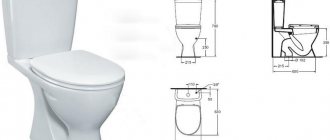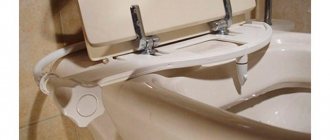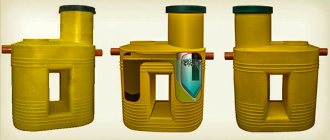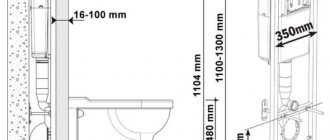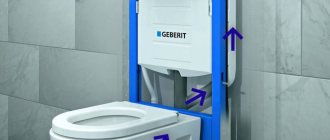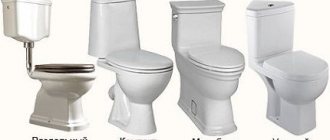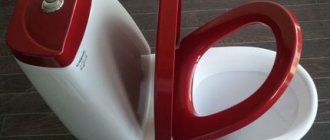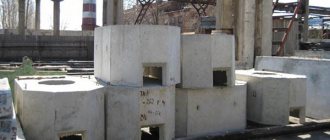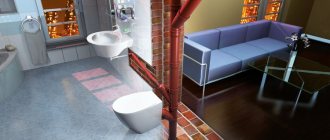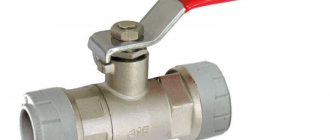Conventional compact toilets are gradually replacing models with a cistern hidden in a wall or partition and a hanging bowl. This solution requires hidden installation of all bathroom communications, but the benefit is obvious - even a small room becomes visually more spacious and the interior more laconic.
This can be done by installing a toilet installation - a special supporting structure that combines the bowl and tank into a single whole. Installation of such models is more difficult than “compact” models, but detailed instructions for installing a wall-hung toilet and installation make it easier for even a non-professional to do the work themselves.
How the installation works
A common element in the design of all wall-hung toilets is a plastic tank with a flush button, which stands in a steel frame. The design also includes holes for fastening to enclosing surfaces, studs on which the bowl is mounted, and two elbows for flushing and draining. And depending on the method of installation and fastening, the following types of wall-hung toilet designs are distinguished:
- Block system. This is a suspended structure designed for attachment to a load-bearing wall (major apartment or interior partition). No support to the floor is provided. Can be mounted in a niche or attached to a surface. In the second case, it is necessary to fill the space from the floor to the block with bricks so that the bowl does not push through the lower part of the casing of the box or false wall.
- Frame system. Designed for installation near load-bearing and self-supporting walls made of building blocks or frame walls and internal partitions with thin sheet cladding. The load is taken by supports standing on the floor. Fastening to the wall secures the structure in a stable position.
- Corner system. A subtype of frame system for installing a toilet in the corner of a bathroom. The legs take the load. The rear part of the system provides for fixation to two adjacent walls located at an angle of 90°.
The dimensions of installations depend on the manufacturer and model.
For example, frame installations from the companies GEBERIT and [email protected] have a standard height of 112 cm and a width of 50 cm; for the GROHE brand, the dimensions are 113 cm and 53 cm, respectively. There are narrow and tall models from WISA (118×38 cm) and SANIT (118x45 cm). But you can find low designs - for example, the SANIT company produces a model with an installation height of 82 cm and a width of 53 cm.
A special feature of the frame installation is the ability to adjust the legs in height. It can be increased by 20 cm. And the size indicated in the diagram is given taking into account that the distance from the floor level to the axis of the drain elbow must be at least 22 cm.
The installation depth also does not have a fixed standard. It depends on the volume of the tank, the height and width of the frame and how the sewer pipe runs. With standard dimensions and a flush volume of 6/3 l, the minimum installation depth is in the range of 12-15 cm. If the tank has a function of increased flush volume (up to 9 l), then its installation depth can be greater - up to 20 cm. But the maximum the depth (distance from the wall to the edge of the frame) for most models does not exceed 23 cm.
Note. Leading manufacturers equip their installations with tanks with a factory flush setting of 6/3 liters and the ability to configure them for an economy mode of 4/3 liters. For some installation models, the volume of the tank allows you to configure operation in the flush/stop mode with a large volume of water - up to 9 liters.
The dimensions of block systems range from 45 cm to 110 cm in height, the width is usually about 50 cm (from 44 cm to 53 cm), and the depth ranges from 12 cm to 20 cm.
Note. There are block systems with a depth of 8-17 cm, which are classified as frameless installations. The GEBERIT company calls such models a concealed cistern. They can be installed in any walls and equipped with floor-standing toilets. The block consists of a tank with mounting plates, a front button and a flush elbow. But if the load-bearing capacity of the wall allows, the wall-hung toilet can be mounted separately from such a block installation.
Wall hung toilet with installation
Installation systems are used to install plumbing fixtures.
This design can withstand a load of up to 400 kg - more than the total weight of the toilet (within 20-40 kg) and a person.
Frames provide more freedom for toilet placement compared to block installation and require less time, although they are more expensive.
Construction device
The design of a wall-hung toilet consists of three elements:
- installations;
- hidden tank;
- bowls.
The tank is attached to the top of the installation. It can be hidden behind a plasterboard partition or walled up in a wall niche. The bowl is suspended on special pins, which are installed in holes in the lower part of the frame.
Frame (module) made of steel
The steel frame can be called the basis for attaching the bowl.
To increase stability and increase the maximum load that the structure can withstand, it is attached to the walls and floor. It is not recommended to attach the system to plasterboard partitions. The steel module is equipped with a device for height adjustment. With its help, the bowl can be installed at a height of 40 to 43 cm from the floor. Fasteners for the frame must be included in the wall-hung toilet kit.
Hidden cistern
An important element is the plastic drain tank. It is mounted inside the frame and differs in shape from its counterparts for conventional toilets. In order to save space, the depth of the tank is made relatively small, although the volume is approximately the same. The exact dimensions of the container depend on the model.
The tank has a special cutout. Its main function is to install a button for flushing water. The second is to provide access to the parts of the drain mechanism. The presence of a cutout allows you not to break the tiles if there are any problems with the wall-hung toilet.
Bowl
The last part of the system is the bowl. It differs in the following parameters for different kits:
- a shape that can be round, rectangular or oval;
- manufacturing material - toilet bowls can be porcelain, earthenware, steel, plastic, and sometimes even glass or polymer concrete.
The best options include porcelain bowls with a circular flush. Their advantages are the absence of corners, which reduces the risk of hitting, and a fine-porous structure that protects the surface from dirt. Circular flush reduces splashes and increases cleaning efficiency.
Operating principle
The installation system works on almost the same principle as conventional toilets:
- After pressing the button or lever at the bottom of the tank, the valve rises.
- Water comes out of the opened hole, washing the bowl.
- When the container remains empty, the button returns to its original position.
- The valve lowers under its own weight, closing the hole.
- As the water level decreases, the float moves down, opening the shut-off valve.
- The tank is filled with liquid, the volume of which is usually in the range of 6-10 liters.
Simultaneously with the filling of the container, the float rises up. Having risen to a certain level, it closes the valve. The water supply stops and the tank is ready for use again. The two-level flush allows you to adjust the volume of water, and filling begins when you release the flush button.
Is it worth hanging such a model?
Reasons for choosing wall hung toilets include:
- the smaller area occupied by such a structure, installed closer to the wall;
- reliability of drainage – systems break down less often and last longer;
- high drainage efficiency ensured by the design of tanks and bowls.
Another advantage is the ease of use of such a system. The smaller surface area of the wall-hung toilet saves time on dusting. The lack of legs in the plumbing fixtures makes cleaning the room easier. It is more convenient to wash the floor under a wall-mounted toilet than around a conventional model.
How to determine the installation location of the system
To choose the right model of installation and toilet, you need to decide on the location.
If we are talking about replacing an old model of a floor-standing toilet with a wall-hung one, then this place has already been chosen taking into account the size of the bathroom and can be left for installing the wall-hung model. The design with a hanging bowl will not violate the ergonomic requirements for the size of passages, minimum dimensions on the sides and in front of the toilet.
When installing a toilet installation with your own hands in a new place (during reconstruction or remodeling of a bathroom), the following requirements must be taken into account:
- the toilet bowl should be located as close as possible to the sewer riser to ensure a normal slope angle of the sewer pipe, and the upper edge of the bowl (without a lid) would be above the floor level at a standard height of 40 cm;
- the minimum distance from the front edge of the bowl to the wall, door or other plumbing fixture should be 50 cm, optimal - 75 cm;
- the minimum distance from the center line of the toilet to the side walls, furniture or other plumbing fixtures is 38 cm, the optimal is 45 cm.
Note. The minimum and optimal distances are indicated taking into account the “average” size of a person, which provides comfortable conditions for 90% of plumbing users. For large people, these sizes are selected individually.
There are also recommendations for placing a special accessory - a toilet paper holder. It is advisable that it be located on the side wall, slightly in front - at a distance of 20-30 cm from the edge of the bowl and at a height of 60-70 cm from the floor level.
After choosing a location, depending on the nature of the wall, the possible method of fastening and hidden installation of communications, the type and specific model of installation is selected.
Advantages and disadvantages
Installation toilets have the following advantages:
- Attractiveness and aesthetics;
- Minimum dimensions allowing maximum free space to be used in small rooms;
- The missing legs and support simplifies the cleaning process;
- Versatility of design, providing a choice according to taste and budget;
- Failures rarely occur, and if they do occur, repairs are not complicated.
The disadvantages include high cost. Taking into account the installation features with the need for additional work, the installation price can exceed up to 2 times the price of placing a floor-standing analogue.
But given the growing popularity, manufacturers have organized the release of relatively inexpensive models that are becoming available to a wider range of consumers.
Another disadvantage is the presence of hidden elements that are not very accessible for maintenance and repair.
Installation diagram for toilet
Each model has a diagram for installing a wall-hung toilet, which shows:
- general dimensions of the frame - width and height (without taking into account the adjustment of the legs);
- minimum distance from the floor level to the axis of the drain elbow;
- height of the flush key;
- the location and height of the water supply pipe to the tank;
- diameters of drain and water pipes;
- center-to-center distance of holes for mounting the bowl;
- frame attachment points.
Markings for installing the toilet installation are carried out based on this diagram.
What to look for when choosing
Installations under the toilet are sold both complete with the bowl and separately. It’s easier, of course, to buy everything in a set. Then all sizes will exactly match. If you already have a bowl, you will need to look at the dimensions of the frame and the distance between the fasteners - it should coincide with the mounting holes in the toilet.
It is very useful if the frame has the ability to be adjusted in height - you can set the bowl to the level you need. Pay attention also to the type of painting. The best option is powder coating. It is reliable, creates a tough, durable film that adheres well to metal. All other types of paint hold up worse.
Installation dimensions Grohe Rapid Sl (Germany)
When choosing an installation for a toilet, you should pay attention to the equipment. Usually, fastening elements are included with the frame - for hanging the toilet, fittings for fixing sewer and water pipes. Some companies also include a tank and a drain button as standard. The drain, by the way, can be dual-mode. It is more economical, since when you press the large button, 6-9 liters are drained, and the small button - only 3-4 liters of water. It’s good if the drain is adjustable - the volume of flushed water can be adjusted to the specific shape of the toilet.
Which type is better?
Which type of installation for toilet and bidet is better? The frame structure is considered more reliable - it usually uses thicker metal, but it also costs more. In any case, when choosing a frame for a wall-hung toilet, pay attention to the strength of the structure - it should not wobble, its elements should not sag. Inspect the welds and the quality of the paint - there should not be even small flaws.
And a little about the manufacturers. The best toilet installations are those made in Germany and Italy. But their plumbing is expensive. The quality of equipment for bathrooms and toilets is made in the Czech Republic and Bulgaria, and the price range for their products is average. The cheapest installations and wall-hung toilets are Chinese, but dealing with them is risky - they can work fine, or they can quickly fail.
How to properly pre-mark
Before you begin installing the toilet with your own hands, you need to make preliminary markings on the wall and floor.
First, determine the vertical, which must coincide with the axis of the frame. There are three options:
- Separate bathroom without washbasin and bidet. In this case, the vertical runs through the center of the wall on or near which the installation is installed.
- Bathroom with toilet and bidet. Both installations are lined up. And the vertical axes for each frame should be positioned so that they fall in the center of the selected location, taking into account the ergonomics of the bathroom. Under standard conditions, both axes should “divide” the wall into three equal parts.
- Combined bathroom. The vertical line on the wall should pass through the geometric center of the selected location.
The next step is to mark the vertical center of the drain button. For a block system, this is the only reference point, and it is usually located at a height of 1 m above the finished floor level. Therefore, you need to take into account the thickness:
- leveling screed;
- heated floors with insulation and their own screed (if provided);
- finishing layer (tile adhesive plus tiles).
For a frame installation of standard height, this size (1 m) is specified in the diagram, but if it is short, then they are guided by the installation height of a particular model.
Further marking is carried out as follows:
- A horizontal line is struck level in the center of the key or the top of the frame and the installation width is marked on it.
- From these points, vertical lines are drawn down. They continue on the floor parallel to each other and perpendicular to the plane of the wall.
- Mark on each line a distance greater than the installation depth indicated in the passport. The actual size must also take into account the gap from the tank to the wall of 1.5 cm, the method of laying the sewer pipe and its maximum outer diameter at the joints. So, with an installation depth of 12 cm, the minimum distance from the wall to the front surface of the installation is 13.5 cm - if the pipe “goes” under the ceiling, 15.5 cm - if the sewer pipe runs along the wall. And this does not take into account irregularities.
- Connect the marks - this will be the line along which the places where the legs are attached to the floor are located.
- Check the perpendicularity of this line relative to the side wall. If necessary, adjust it, making sure that the shortest distance to the wall is no less than the actual depth.
Marking on the wall for a block installation is much simpler and consists only of marking the attachment points to the wall. In accordance with the diagram and focusing on the recommended height of the flush button, a parallel line is struck from the vertical axis on each side at a distance equal to half the installation width. And on these lines the points of attachment of the frame to the main wall are marked.
Types of installation systems
There are several types of installations; they differ in design and size (in particular, depth and height). To choose the right system, it is recommended to study the main features of the varieties. There are 3 types of installation systems for wall-hung toilets:
- block;
- frame;
- angular.
Sometimes installations are classified by purpose: there are models suitable for a specific type of plumbing fixture, as well as universal options. There is also a separate corner installation for the toilet. It is not used very often, but is irreplaceable if there is a minimum of free space in the combined bathroom.
Block
The design in such models consists of 2 elements: the toilet itself and the built-in module.
The toilet bowl is suspended using special fasteners or mounted on the floor, and the built-in module is installed behind a false wall. The cistern can be suspended, walled up behind bricks and cement, or hidden behind a plasterboard or plastic partition. Block installation is characterized by the following features:
- a flat cistern, additionally reinforced, having a small thickness, but a large width and height;
- original elements for fastening.
Block installation has a shallow depth and is low cost compared to a frame system. Installation is carried out on a solid wall. When choosing a standard (non-hanging) model of plumbing, the only difference from a conventional system will be only in hiding the cistern.
Due to the fact that the installation is almost completely built into the wall, it is best if a small niche is pre-arranged in it. This type is chosen when the budget is limited or when it is necessary to provide free access to the system.
The main disadvantage is that the installation of a toilet bowl can only be carried out if there is a solid wall. If it is missing, it is better to pay attention to another type of system, because under the weight of a sitting person, the thin partition will break.
Frame
The basis of the system is a durable frame made of steel, which is coated with an anti-corrosion solution. To ensure increased strength of the installation, in some cases the components are connected by welding. It is the steel frame that takes on the entire load: the weight of the elements, the body weight of a sitting person and water.
The main advantage of an installation for a toilet of this type is the ability to install it anywhere in the bathroom where a sewer pipeline and a water supply pipe can be connected. Frame systems differ in purpose. There are options suitable only for a bidet or toilet, and there are also models that are installed with different types of plumbing fixtures.
Installations of this type are free-standing, they are not fixed to the wall, and all the weight is transferred to strong reinforced legs. Therefore, unlike a block system, such a system can be installed even on a not too thick partition made of plasterboard.
There are several types of fastenings:
- 4-point wall mounting;
- fastening to the floor, this design has additional supports;
- fastening at 2 points to the floor and at 2 points to the wall.
Corner
Corner installation systems for the toilet are installed in situations where the free space of the toilet is limited, but it is possible to install plumbing fixtures in the corner. As a rule, such models are fixed on the walls. They also allow you to create a unified bathroom interior design and make the room larger, but their installation will cost a little more.
Main advantages:
- compact size, allowing installation of models even in the smallest rooms;
- visual increase in space due to the fact that the center of the toilet is not cluttered with plumbing;
- you can place the toilet together with a sink or bidet;
- there is 40 mm of space within which the height of the product can be adjusted;
- Toilet bowls, as a rule, have increased strength and wear resistance; even under heavy loads, cracks and other damage do not appear. Despite their external fragility, the installation can withstand up to 500 kg of weight.
Watch the video
The peculiarities of the corner variety include the need for installation only in combined bathrooms. When installed in standard rooms with a lot of free space, such a model will visually make the room smaller.
Materials and tools
Even when purchasing the installation, you need to check the completeness. In addition to the frame itself, the tank, the inlet valve and the flush elbow must be:
- drain elbow;
- key;
- fastenings and fastening elements;
- plugs for flush and drain pipes (to prevent debris from getting in during operation);
- gasket for mounting a wall-mounted toilet (sound insulation).
In the case when you are installing plumbing fixtures yourself for the first time, it would be good to find out if the seller has spare parts for installation (if something goes wrong). All leading manufacturers produce spare parts and repair kits for installations - pipes, elbows, inlet and flush valves, membranes, seals and transitions. In addition, there should be a variety of different types of fasteners and fasteners that can be purchased separately.
You also need to purchase a set of pipes for connecting the wall-mounted toilet to the installation, silicone sealant for the joints of sewer pipes and fum tape for installing a stop valve on a water pipe.
To install a wall-hung toilet with installation, you will need the following tools:
- level, tape measure, ruler, construction corner, pencil or marker;
- hammer drill and concrete drills;
- hammer;
- a set of wrenches (as well as an adjustable or gas wrench);
- screwdrivers;
- pliers.
If you immediately install a frame from a profile for subsequent sheathing with plasterboard, then you also need a tool for this work:
- metal scissors;
- drill;
- knife or hacksaw;
- screwdriver
How to mount a toilet without installing it on a concrete base
One of the main disadvantages of the installation is its high price. But this disadvantage can be compensated for by choosing another installation option - installation on a concrete base or embedding into a wall. The method is considered the most economical, although it requires more time to implement.
Preparation
To install plumbing fixtures on the wall, you will need to prepare the following tools and materials:
- about 40 liters of concrete grade M200;
- 2 rods 500-800 mm long and 20 mm in diameter;
- plastic pipe with a diameter of 110 mm and a length of 80 mm;
- drain coupling;
- sealant (it is recommended to choose silicone);
- boards for formwork;
- a small amount of foam;
- nuts, washers and wood screws.
Installation should only be performed on solid walls. Partitions and drywall cannot support the weight of the toilet.
Installation
The installation process includes the following work:
- Fastening the rods to the wall.
- Installation of drain coupling.
- Arrangement of formwork with marking of places for fastening.
- Temporarily install the bowl in place to check that all holes line up.
- Concreting, during which foam plastic is installed in place of the drain hole.
- Installation of the toilet on the base, which can only begin after the concrete has completely hardened - 28 days after pouring.
The procedure for installing a bowl on a concrete base is practically no different from installing it on an installation. The toilet is installed on pins and connected to the drain. At the last stage, a drain tank is mounted on the base.
You can do the installation of wall-hung toilets with an installation or on a concrete base yourself. Before doing this, you should carefully read the instructions to avoid serious mistakes. If the owner of a home where such plumbing is installed has doubts about his own abilities, he should entrust the work to professionals.
Features of installation and toilets installation
As mentioned above, there are three options for “installation and toilet” combinations.
Wall-hung toilet with block design
The easiest way to install the system yourself is to install the frame on the surface of the main wall and lay a quarter-brick partition below the structure to provide a reliable support for the wall-mounted toilet. The butt size of a single brick is 12.5 cm plus 1 cm of a vertical joint made of masonry mortar, and the resulting 13.5 cm is just right for most models whose installation depth lies within these limits.
Another option is to purchase a block installation, which includes two special floor supports to “support” the wall-mounted toilet bowl. These supports are placed on the sanitary ware fastening pins, and they do not allow the bowl to “fall” back. Such models include Geberit Kombifix (110.340.00.5). If such accessories are not included in the kit, they can be purchased separately, for example Geberit Kombifix stops (457.888.26.1) or Alcaplast mounting kit (M90).
Do-it-yourself installation of a block installation proceeds according to the following algorithm:
- At the marked fastening points on the wall, holes are made with a puncher, to which the frame is screwed with dowels.
- Drive in dowels or anchors and screw the frame to them.
- Insert the tank into the frame, connect it to the water pipe (the water supply tube may be included in the delivery package) and to the flush elbow.
- Screw in the mounting studs to secure the bowl.
- Connect the drain elbow to the sewer through an adapter pipe (from the kit or purchased additionally).
Wall-hung toilet with frame installation
This is the most common type of hidden installation design - it is suitable for installation near any wall or partition, regardless of its load-bearing capacity.
Simple and clear instructions for installing a wall-hung toilet
Frame installation
Holes for dowels are made on vertical and horizontal surfaces according to the markings.
Adjustable bolts and nuts from the kit are screwed into them. The frame is set using a building level. The height is adjusted with screw feet, the depth with wall screws. All connections must be secured. Otherwise, under the influence of vibration, they will weaken or become unusable. This will lead to the frame and tank falling and damage to the entire structure. Install the studs that come with the kit. When securing the bowl, you can use store-bought pins, but their strength should be taken with reserve. The console puts a large load on the base. The kit may include extended studs that extend through the frame and are secured to the wall.
Communications liner
Water comes to the tank from the HVO pipes. If the toilet has a bidet function, hot water is also connected. If the hoses are not included in the kit, standard fittings are used for the connections, as for conventional plumbing. Flexible hoses are not reliable. It is better to use metal-plastic products. The connection is made from above or from the side.
Communications are carried out in hidden channels or boxes. It is prohibited to hammer reinforced concrete slabs. According to current regulations, work that worsens the load-bearing capacity of walls and floors is prohibited, so the restriction may also apply to brick and monolithic structures. The laying may be carried out in a layer of plaster or in another coating that does not affect the strength of the building.
Instagram @dnevnik_domostroitelya
Instagram @dnevnik_domostroitelya
Instagram @dnevnik_domostroitelya
Instagram @dnevnik_domostroitelya
To connect to the sewer riser, you need to prepare a plastic or cast iron pipe with a diameter of 10 cm. Its far end is coated with sealant, connected to the entrance to the riser and secured with a clamp tightened with a screw. The other part is fastened to the frame with a clamp. This part is L-shaped. The plumbing fixture is connected to its horizontal top.
If you are far from the riser, the drain will have to be raised so that the water inside does not stagnate. The slope should be 2-3 cm per 1 running meter. The sleeve is hidden in a removable box or channel in the ceiling. In the latter case, they make a screed, leaving free space in the corner. With a significant slope, it will turn out to be too massive and high.
In typical apartments, this technique cannot always be used. It is better to calculate all the nuances before starting work. When installing a toilet installation, the installation dimensions must be known in advance. This will save time and prevent mistakes. When all the power elements are installed and the pipes are connected, the system is checked again and covered with a false panel.
Instagram @kah.life
Instagram @kah.life
Installation of a gypsum plasterboard partition
It is cut out from a sheet of plasterboard along the width of the niche, after which holes are made in it for the pins, a drain that supplies water to the bowl, and a drain. When installing a shower toilet, you will need to drill holes for the faucet that supplies cold and hot water. If the buttons are located at the front, a niche for them is made at a height of more than 1 m from the level of the finished floor covering.
They use plasterboard with a green color - it easily withstands moisture. They cover a frame made of aluminum profile. Its guides are attached to the floor, walls and ceiling with dowels, then connected with stiffening ribs. Their number depends on the mass of the wall covering and the thickness of the profile. The joints of the sheets should not hang. They are screwed to metal parts and covered with putty.
If the edges are not secured, the putty will quickly peel off due to vibration. After the cladding is completed, it is lined. They move on to the next stage only after the tile adhesive, plaster or other finishing material has completely set. This takes from one to several days.
ShutterStock
ShutterStock
Mounting a wall-hung toilet
The toilet is mounted on a pre-prepared false wall. We present the technology for carrying out the work.
- Adjust the dimensions of the drainage pipe. It should protrude 50 mm above the wall surface.
- Do the same with the pipe, which is inserted into the sewer drain.
- Install pipes adjusted to size in the designated seats.
- Take a toilet gasket; its shape resembles a pyramid. Place on previously installed studs. Their position determines the height of the suspended structure.
- The bowl is carefully placed on the mounting pins. The pipes are brought in and inserted into it.
- Place the plastic inserts and rubber gaskets in place.
- Install and tighten the fastening nuts. This is done carefully so as not to damage the ceramics. Excessive force may cause it to burst.
- Using a sharp knife, cut off the protruding parts of the rubber gasket.
Installation of the flush key
The installation is completed by installing a flush key, one or two. This depends on the model of the hanging equipment. There are pneumatic and mechanical varieties. In any case, there are no problems with installation, since all the nodes and connections necessary for their operation are already displayed on the panel.
To install a mechanical key, pins are used, and the pneumatic key is secured using small tubes. The parts are placed on the panel and connected to the removed nodes. Then, if necessary, adjust their position. Sometimes they do without them.
Attaching a floor-standing toilet to the installation
Correct installation of a floor-standing toilet on an installation is only possible if the tiles on the floor have already been laid or there is an exact level of the finished surface. In this case, markings are made on the wall by selecting the center of the flush hole in the toilet as the reference point rather than the flush key. And the installation takes place in the following order:
- Select a location for installing plumbing fixtures.
- They mark a vertical axis on the wall. Mark on it the point of connection of the floor-standing toilet to the flush elbow of the cistern.
- The dimensions of the block installation and attachment points are noted relative to this point.
- The tank is secured (in a niche, on the wall, in a frame partition).
- Connect to a water pipe.
- Install the flush elbow.
- They make a sewer line (along the wall, in a grooved channel, inside a frame partition.
- The system and toilet are temporarily connected. Check the operation and tightness of the system.
- Close the flush and drain pipes with plugs, and the studs with tubes.
- The installation is covered with plasterboard (with holes for flushing and draining). Or they seal the niche and grooves with mortar.
- The wall is being finished.
- Connect and secure the floor-mounted toilet.
Preparing the bathroom
Installation of the installation is carried out before finishing work in the bathroom. Moreover, “before” means that the tiles have not yet been laid on the floor, and in some cases there is even no screed, and the walls have not been plastered.
Before installing a wall-hung or floor-mounted toilet along with the installation, choose a suitable location. The optimal place for installation is the least accessible place or the one farthest from the door: the plumbing fixture should not be located in the passage. In limited conditions, the installation should be mounted in a corner. In general cases, plumbers do not recommend moving the location of the unit, but advise putting the toilet in the same place where the old one stood. This will greatly simplify the work. A niche with risers is suitable for installation, but the risers will have to be moved apart.
If the installation site is moved, it is necessary to maintain the correct slope of the sewer pipes to the drain (2 cm by 1 m). In addition, the toilet should be located closer to the sewer drain than other plumbing fixtures, otherwise when the water is drained, the water seals will break and a sewer smell will enter the room.
If the floor screed has not yet been poured, calculate its height. Sewer and water pipes are connected to the installation site. All pipes must be secured to prevent them from moving before the screed is poured.
Sometimes the design of a room requires:
- installing a toilet under the window;
- installing a plumbing fixture on a partition separating the space of the bathroom.
In the first case, it is necessary to purchase a low installation (below 82 cm), in the second, it is advisable to use a double frame structure, which is more stable.
On the wall, mark the central axis, the contours of the installation, the location of the tank, holes for fastening, including on the floor, setting aside the required distance from the wall (at least 13.5 cm).
Recommended dimensions to follow: seat from the floor - 43 cm, button from the floor - 100 cm, frame from the wall - 15 cm, tank from the wall - 2 cm.
Installation procedure for a wall-hung toilet
The hanging bowl is installed after the installation for the toilet has been installed and the finishing work has been completed. And depending on the type of installation, installation method and wall materials, there are the following options for preparation for finishing:
- install a block or frame system and cover the entire surface from floor to ceiling with a double layer of plasterboard;
- install a frame or block system and make a box from plasterboard;
- install a frame system in a frame wall;
- install a frame or block system in a niche and cover it with plasterboard or cover it with a layer of plaster.
After the installation and communications are “hidden” under the rough surface of the walls and floor, finishing is carried out with selected materials (tiles or decorative plaster). Then they begin to install the wall-hung toilet.
Note. It is believed that the maximum benefit from the hidden installation of the tank and communications is achieved if the installation for the toilet is installed in a niche.
Advantages and disadvantages of wall-hung toilets
Wall-hung toilets are gaining popularity due to their main advantages over floor-standing ones:
non-standard appearance allows you to create an exclusive interior
Thanks to its design features it saves space
Hidden installation of all communication pipes and hoses will give the bathroom a more aesthetic appearance
free access to the floor covering will facilitate cleaning work
Despite the large number of positive characteristics, the wall-hung toilet has some disadvantages:
higher price for the suspension system range
quite complex installation, requiring skills in this work
hidden communications create difficult access during maintenance
Niche for installation
A niche is made in the wall for installation if the installation depth of the frame, materials and wall thickness allow such work to be performed. And in addition to the niche in the wall, they also cut channels for water and sewer pipes, which, like the installation, must be installed secretly.
Important. This method is not suitable for load-bearing walls made of bricks (for walls made of reinforced concrete, it is technically impossible to make a niche with your own hands). And if the arch of a niche can be reinforced with an insert made of a metal profile (standard practice for an opening), then this option is not suitable for hidden pipe laying - cutting horizontal channels in a load-bearing wall is prohibited at the regulatory level.
And without horizontal grooves, it is extremely difficult to make hidden wiring - only if the pipes approach the niche from below, and before it are laid in a screed or between the joists of a wooden floor.
For a niche in the wall, there is only one option provided by the manufacturer - for a block installation with an attached toilet.
In addition to this option, they also use a bathroom niche in which the water supply and sewer risers pass. In this case, a frame made of a metal profile is installed in a niche, and a frame installation for a wall-mounted toilet is attached to it.
Installation of a frame with a tank in a niche
The complexity of this method is that the installation of the frame in the niche is “non-standard”. The installation instructions from GEBERIT and GROHE do not cover this option, and the kit does not include fasteners for this.
Installation of the frame in a niche proceeds according to the following algorithm:
- Mark the line for installing the legs on the floor, taking into account the installation depth, the location of the water and sewer risers. The markings must be perpendicular to the walls of the niche or in the plane of the adjacent surface.
- The verticals on the walls of the niches are set off from this line.
- Mount reinforced guides of the UA50 profile on the floor, side walls of the niche and ceiling.
- Install the frame into the profile and fasten it to the floor, having previously drilled holes for the dowels.
- Set the height of the legs and the horizontal level of the frame.
- Fasteners (studs or other type of fastening) are made to a specific size to rigidly fix the installation to the “far” wall of the niche. Drill holes for these fasteners and attach the frame.
- Cut a section of the UA profile to the width of the niche. Attach it to the side profiles and frame.
- Install flush and drain fittings for a wall-hung toilet. Install studs to secure the bowl. Connect the tank to the water supply and the drain elbow to the sewer. Temporarily hang the toilet and connect it to the installation. Check the system for leaks and operability.
- Remove the tank, close the flush and drain holes with plugs, and close the toilet studs with protective tubes. Attach plasterboard cut to size to the profiles in two layers.
Sewage supply
Supplying water to the toilet installation does not cause any difficulties. And for any connection of the tank (from the side or from above), you can always lay a half-inch rigid or flexible pipe. With connection to the sewerage system the situation is more complicated. The diagram for the installation shows two types of connections:
- the knee goes down at a right angle;
- the knee is rotated 45° in the plane of the frame.
In most cases, the connection of the installation to the sewer system is based on these options.
The first option, for example, is used for direct connection to the drain, when the frame stands in the same niche as it. The second option is used when laying a drain pipe to the riser along the wall.
But there are cases when both options are not suitable due to limited space and the unique geometry of the bathroom - the large diameter of rigid pipes and fixed elbow angles prevent this from being done correctly. And to solve the problem of how to turn the sewer elbow away from the installation and provide the required slope angle, corrugated adapters are used. For example, corrugation D 90/110 MM FLEXI from ALCAPLAST. But in this case, it is necessary to check the slope of the corrugation.
Connecting communications
To connect to the water supply, the installation kit includes an inlet valve with an external outlet for a ½-inch pipe and an angle shut-off valve inside the installation.
For toilet installations with a bidet function, an additional tube is provided for the intimate hygiene fitting. And to ensure a comfortable temperature, such models are also connected to the electrical network to heat the water that is used for washing. And for this purpose, fastenings are provided for mounting the protective tube of the electrical wiring.
How to check the system for functionality
After connecting to communications, before sewing up the installation, it is necessary to check the operation and the system for leaks. To do this, pre-install the toilet with the following installation:
- adapters with cuffs and sealing rings are inserted into the flush and drain holes of the installation;
- “put” the toilet on the studs and move it as close as possible to the installation so that the adapters fit more tightly into the toilet (it won’t be possible to push it in tightly - the pipes are too long);
- open the shut-off valve on the inlet valve;
- when the tank is full, drain the water (for pneumatics, you need to connect the button and flush valve with tubes, for mechanics, activate the flush valve rod by hand).
After checking and eliminating possible malfunctions, the toilet bowl, adapters and button are removed.
How to install a wall-hung toilet to an installation
Even when choosing a location and marking, it is ensured that the height of the wall-hung toilet from the floor without a lid is 40 cm. But if after laying the tiles it turns out that it will hang 2 cm higher or lower, this is acceptable.
The wall-hung toilet is mounted on studs after adjusting the size of the adapter pipes for connecting the toilet drain and flush to the installation:
- Remove the protective plugs and tubes.
- Insert the adapters into the elbows and mark the level “0” on them - the plane of the surface of the installation cladding.
- Then insert the adapters with the other side into the toilet (put a sealing cuff on the flush bowl). About the toilet.
- The adapters are shortened by the difference between the two marks.
Place a gasket on the studs (it serves to protect the finish and dampen structural noise during flush operation) and begin installing the wall-hung toilet on the installation:
- Rubber bushings are inserted into the holes for mounting the wall-hung toilet.
- Insert adapter pipes into the drain and flush holes of the bowl.
- Place the wall-mounted toilet on the studs so that the transition pipes fit exactly into their holes on the installation, and the bowl fits tightly to the wall.
- Place elastic washers and steel washers on the studs and tighten the nuts.
- Before finally tightening the fasteners, you can slightly adjust the horizontal level relative to the height of the toilet from the floor.
Installation of the flush button
According to the principle of operation, there are two types of toilet flush button: mechanical and pneumatic.
Even at the installation assembly stage, a flush valve is installed. Each company has its own design, but the principle of operation is common:
- a mechanical button activates the flush using a pull rod, separate for each key - economy mode and full flush;
- For a pneumatic flush, there are two tubes from the valve to the button—one for each mode.
Installation of the flush button begins with its connection to the flush valve. For a mechanical drive, the rods (pins) must be “adjusted” in length and each connected to its own key, while for a pneumatic drive, the tubes must be connected.
Then the button is “snapped” into the socket.
Common Difficulties
The main problems arise due to the limited size of most bathrooms. This is especially true for strictly residential buildings, when in addition to the small “dimensions” there is added poor geometry of the room - the absence of right angles and parallels in the enclosing surfaces. In this case, even the slope of the wall is checked before installation. And leveling the walls further reduces the room for “maneuver” when installing the installation under the toilet.
The correct choice of type and model of installation, as well as the accuracy of markings, frame location and adherence to the installation diagram will help you avoid mistakes and alterations.
And the main condition is careful handling of mechanisms and sanitaryware. Even “tightening” the fastenings of the intake and exhaust valves or the hinged bowl can lead to a violation of the tightness of the connections or damage to the device itself.
What is important to know. It is necessary to buy installations and plumbing from reputable brands. It is better to do this with dealers or trading companies that have appropriate agreements with service centers and provide a guarantee for the purchased product. In addition, if necessary, you can buy additional accessories or a repair kit for the selected installation model from such sellers.
